Interstellar object 3I/ATLAS is leaving the solar system
Interstellar object 3I/ATLAS has made its closest pass by the sun and is now headed out of our solar system. Perihelion – the closest point to the sun – was at 11:47 UTC (6:47 a.m. CDT) on October 29, 2025. At that time the comet was about 1.36 AU (or 1 1/3 Earth-sun distances) from our star. But it has not yet made its closest pass by Earth. That will come around December 19, 2025, when it’s about 1.8 AU (168 million miles or 270 million km) from Earth.
Comet 3I/ATLAS is currently behind the sun from Earth’s point of view. So, in late October and early November 2025, you can’t see it in Earth’s sky. It will return to our eastern predawn sky for telescopic observers around November 11. At that time, you’ll need at least an 8-inch telescope to see it.
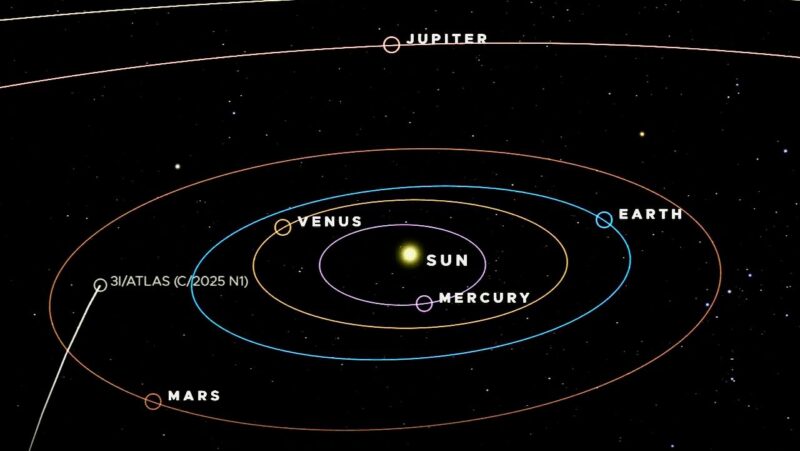
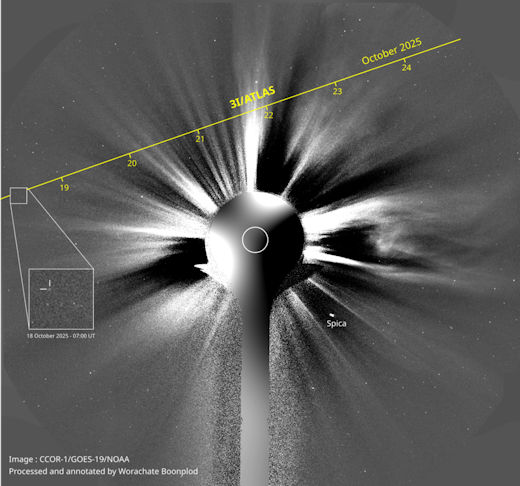
Is 3I/ATLAS visible to the unaided eye?
Alas, 3I/ATLAS will not be visible with the unaided eye from Earth. However, it will be possible to view the object with 8-inch (20 cm) or larger telescopes. And the best time for that will probably be late November, when the object will be in the morning sky.
If you spot it then, you’ll be in good company. Between November 2 and 25, ESA’s Jupiter Icy Moons Explorer (JUICE) will be observing the comet with various instruments. As JUICE looks toward 3I/ATLAS so soon after its closest approach to the sun, it is likely to have the best view of the comet in a very active state, with a bright halo around its nucleus and a long tail stretching out behind it.
JUICE’s team doesn’t expect to receive data from its observations until February 2026. Find out why here.
There are 2 other comets visible (or nearly visible) in our night sky now:
Comet Lemmon might be the best comet of 2025
New comet SWAN is up after sunset, too
There are 3 comets in the sky now that you might be able to see! EarthSky’s Deborah Byrd and veteran skywatcher Bob King, aka AstroBob, show you comets Lemmon, SWAN and the interstellar wonder 3I/ATLAS in this video. Whether you’re new to comet-watching or a seasoned skywatcher, we’ll help you appreciate these icy visitors.
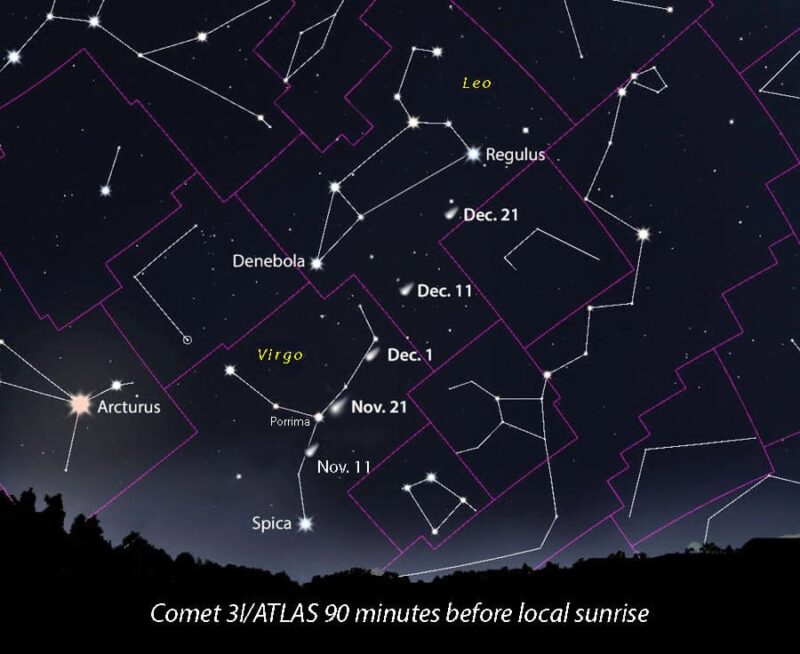
How to track the interstellar object 3I/ATLAS
If you’re interested in tracking the object, NASA’s Eyes on the Solar System tool offers interactive simulations of its path. Also, NASA recently launched a new page devoted to 3I/ATLAS.
There was a lot of excitement when this object passed Mars on October 3, 2025. The hope was that some Mars spacecraft might be turned to see the object. Keep reading to learn what happened.
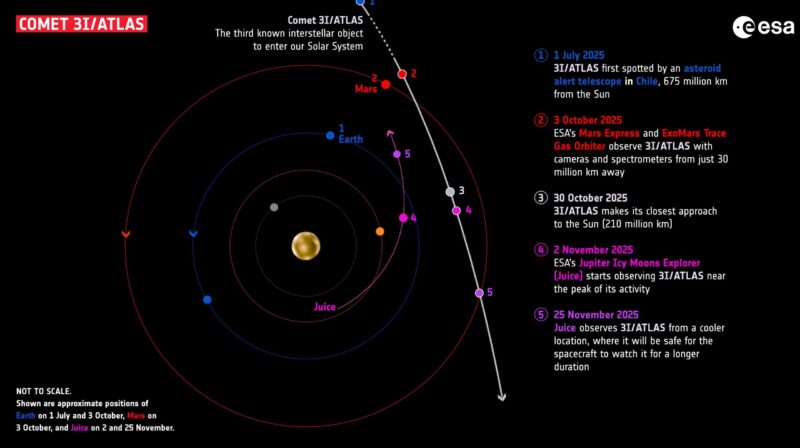
Interstellar object 3I/ATLAS passed Mars on October 2-3, 2025
The world’s 3rd known interstellar object – 3I/ATLAS – made its closest approach to Mars at 4 UTC on October 3, 2025 (11 p.m. CDT on October 2). At that time, the comet was approximately 18 million miles (29 million kilometers) from Mars. It was the object’s closest approach to any planet during its one-time journey through our solar system.
According to the European Space Agency (ESA), both the ExoMars Trace Gas Orbiter (TGO) and Mars Express turned their cameras toward 3I/ATLAS as it passed near Mars between October 1-7, 2025.
TGO’s CaSSIS instrument captured a series of images on October 3, 2025, when the comet was approximately 20 million miles (30 million km) away from the spacecraft. The images showed the comet as “a slightly fuzzy white dot” amidst streaked stars. See an animated gif – made from these images – below.
The images were challenging because the spacecraft’s imaging system is designed for the bright surface of Mars (just hundreds to thousands km away), yet this target was orders of magnitude farther and much fainter. Read more about the flyby and the TGO images here.
So ESA’s ExoMars Trace Gas Orbiter did capture an image, but it did not show much. So far, we have not seen an image from the Mars Express of 3I/ATLAS specifically.

Interstellar object 3I/ATLAS: A look backward
Where did 3I/ATLAS come from? We know it came from the Sagittarius direction in our sky; that is, it came from the direction of the center of our Milky Way galaxy. But there are billions of stars in that direction. Which one is the home system of this object?
There have been many studies and ideas. One team of scientists, led by Xabier Pérez-Couto of the University of A Coruña in Spain, traced the path of interstellar object 3I/ATLAS back 10 million years. The astronomers were seeking its origin star, or any stars that might have perturbed its path as it traveled from its point of origin to our solar system.
The researchers examined 3I/ATLAS’s trajectory with the help of the Gaia space observatory’s data on stars. For 12 years, Gaia collected data on billions of stars in our Milky Way galaxy, precisely noting their positions again and again and thereby determining their motions. These astronomers’ calculations took them more than 100 million astronomical units (AU, or Earth-sun units) from our solar system. With these data in hand, researchers said they identified 93 nominal “encounters” for 3I/ATLAS, 62 of which were “significant.” Yet, they found that none of those encounters produced any meaningful perturbation of ATLAS’s orbit.
So, in other words, all of those 93 (or 62) encounters happened too fast, with the stars too far from 3I/ATLAS to meaningfully impact its trajectory. In the end, they didn’t find a star along 3I/ATLAS’s path that might have been responsible for bringing this 3rd-known interstellar object to us.
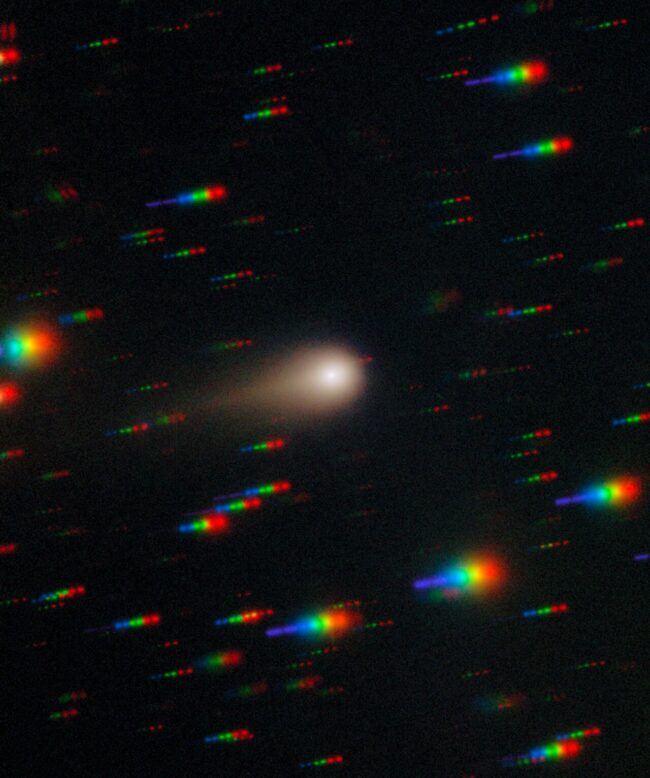
Tracing 3I/ATLAS’ path, a daunting task
And, as you might imagine, tracing 3I/ATLAS’ path backward through the galaxy is a daunting task. That’s in part because small uncertainties in orbits and stellar motions grow rapidly over time. But based on the researchers’ analyses of the interstellar object’s vertical motion in the galaxy (its path is known to weave up and down in the galactic disk), they concluded that it likely originated from the Milky Way’s thin disk, not its thick disk as was mentioned some months ago. The thin disk contains somewhat younger objects than the thick disk. But the researchers’ paper said:
[3I/ATLAS] may nonetheless be an old object, consistent with ejection from a long-lived primordial planetesimal disk in an early-formed system.
The scientists published their not-yet peer-reviewed paper on arXiv on September 10, 2025.
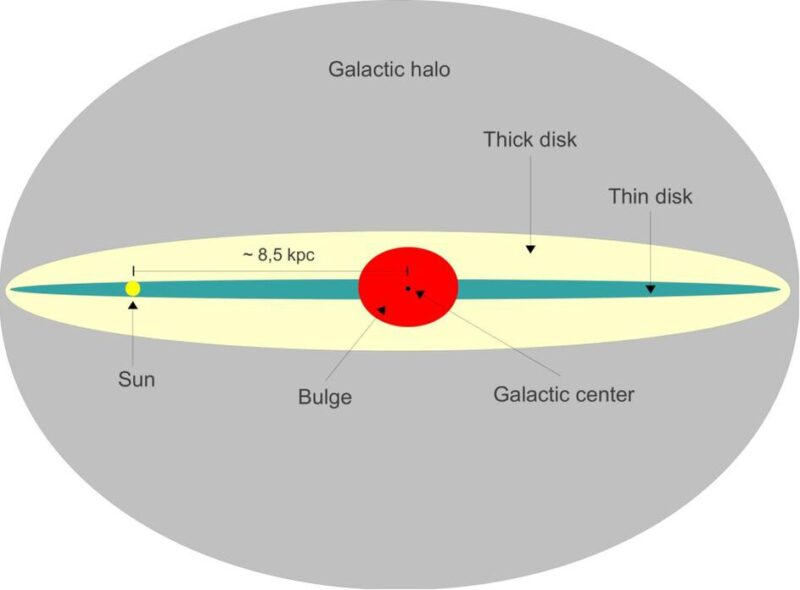
Unlocking galactic mysteries with 3I/ATLAS
3I/ATLAS is thought to have been drifting through interstellar space for many billions of years before encountering our solar system. Pérez-Couto and team said that the interstellar comet is a:
… key probe of the galactic population of icy planetesimals.
In other words, the formation of solar systems is a messy process. In a solar system’s earliest days, rocks and pockets of gas and dust bang into each other and get swept up into clumps, which eventually get big enough to begin gathering yet more rocks, gas and dust to themselves via the force of gravity. Thus, planets come to be, astronomers think. According to theories of planet formation, clearing processes are also common, and those sometimes involve material – often the outer, icy regions of debris – getting ejected from a system altogether. As the paper said:
… interstellar space should be filled with planetesimals.
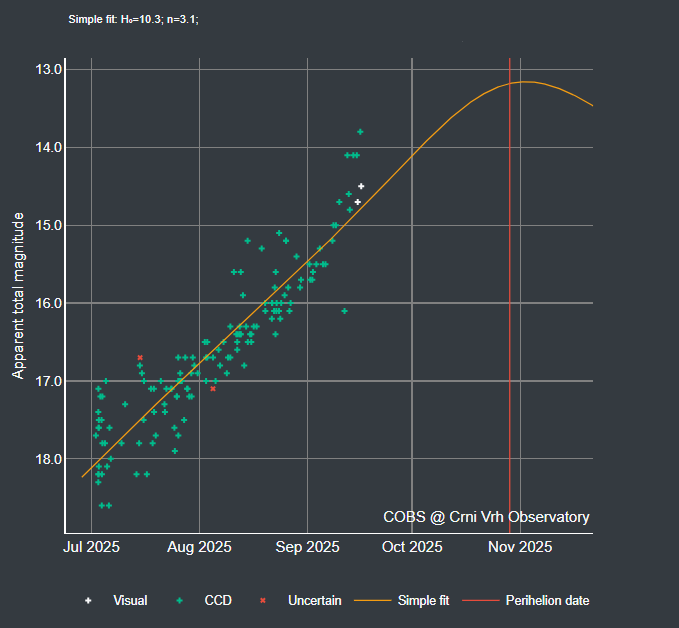
Other possibilities
Plus, there are other ways these interstellar interlopers might have achieved their lonely paths through our Milky Way galaxy. The possibilities range from close passages of other stars to tidal fragmentation of comets. So, as the paper said:
Identifying the origin of interstellar objects is key to understanding planet formation efficiency, the distribution of volatiles and organics in the galaxy, and the dynamical pathways by which planetary systems evolve.
All that from a small chunk of icy stuff (we know it’s icy in part because 3I/ATLAS has formed a tail, as icy comets do)!
EarthSky interview with Colin Orion Chandler
On August 7, 2025, NASA shared an updated estimate of the size of the object’s nucleus, or core. Shortly after the object was first identified on July 1, 2025, 3I/ATLAS was estimated to have a diameter of about 12 miles (20 km). Then in late July – using data from the new Vera C. Rubin Observatory in Chile – the size estimate dropped to 6 miles (10 km). The latest analysis uses data from the NASA/ESA Hubble Space Telescope. It reduces the estimated diameter of 3I/ATLAS’s nucleus still further, to 3.5 miles (5.6 km).
And, the astronomers using Hubble data said, the object could be even smaller, as small as 1,050 feet (320 meters) across!
EarthSky’s Deborah Byrd interviewed Colin Orion Chandler of the DiRAC Institute of the University of Washington about size estimates for 3I/ATLAS. Watch in the player below, or on YouTube.
By the way, the two previously known interstellar objects are 1I/ ‘Oumuamua and 2I/Borisov. ‘Oumuamua’s size is thought to be about 656 feet (200 meters) across at its widest (you’ll recall it has an elongated shape). And Borisov is thought to be less than 3,280 feet (1 km) across.

An early EarthSky interview with Matthew Hopkins
Shortly after the discovery of 3I/ATLAS – on July 1, 2025 – astronomers were saying it was likely the oldest comet we’ve ever seen. That claim came from University of Oxford astronomer Matthew Hopkins, whose analysis suggested 3I/ATLAS might be more than 7 billion years old, predating our solar system by more than 3 billion years! Hear him explain in the player below, or on YouTube.
EarthSky interview with Colin Snodgrass
Scientists first spotted 3I/ATLAS in early July 2025. And since then, one question has been asked countless times: will we send out a spacecraft to take a closer look? EarthSky’s Will Triggs spoke to University of Edinburgh astronomer Colin Snodgrass on August 21, 2025, to find out the answer. Colin essentially said, no, we don’t have time to organize a space mission specifically for 3I/ATLAS. But he talked about a future mission, the European Space Agency’s Comet Interceptor. This upcoming spacecraft will be primed to intercept future interstellar objects. Watch Will’s interview with Colin in the player below, or on YouTube.
It’s worth noting that the behavior of 3I/ATLAS is much like the signature of previously seen sun-bound comets originating within our solar system. But 3I/ATLAS is moving fast. In fact, it’s traveling through our solar system at roughly 130,000 miles per hour (210,000 kph). That’s the highest velocity ever recorded for a solar system visitor.
How they spotted interstellar object 3I/ATLAS
The Asteroid Terrestrial-impact Last Alert System (ATLAS) – a system of survey telescopes – detected our new interstellar visitor on July 1, 2025. And the Minor Planet Center confirmed its interstellar nature the following day (July 2, 2025), naming it 3I/ATLAS (or C/2025 N1). The “3I” means it’s the 3rd interstellar visitor that we’ve found. Its trajectory and speed revealed it as an object not from our solar system, but from another star system.
The Hubble Space Telescope imaged the object on July 21, 2025. See the post from Bluesky below.
Hubble Space Telescope images of interstellar comet 3I/ATLAS are out! These were taken 5 hours ago. Plenty of cosmic rays peppering the images, but the comet’s coma looks very nice and puffy. Best of luck to the researchers trying to write up papers for this… archive.stsci.edu/proposal_sea… ?
— astrafoxen (@astrafoxen.bsky.social) July 21, 2025 at 4:28 PM

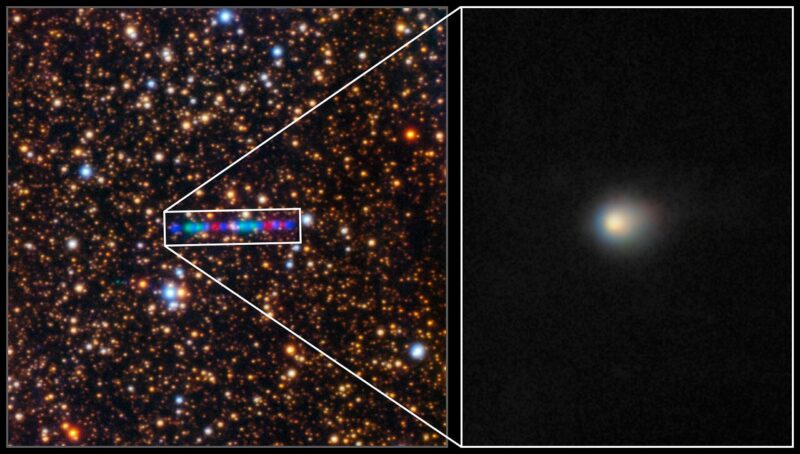


Morning star charts here
After Comet 3I/ATLAS makes its close approach to the sun, you can find it in the morning sky.
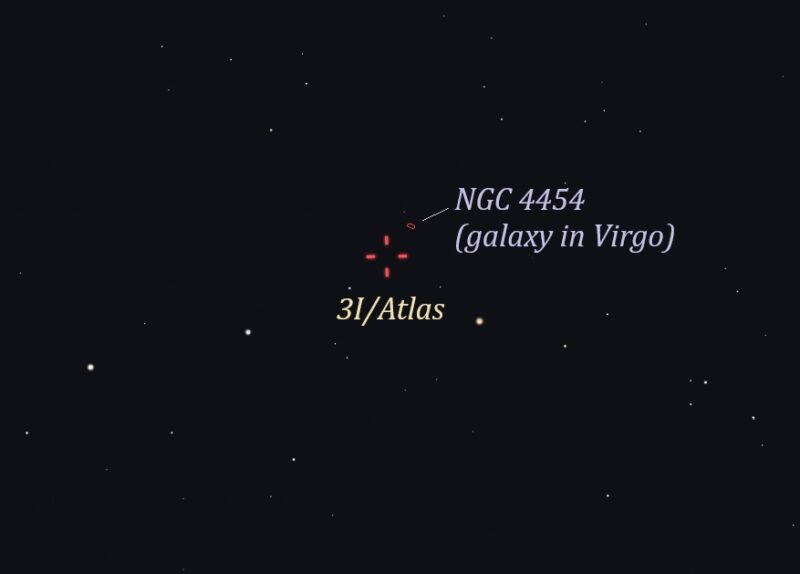
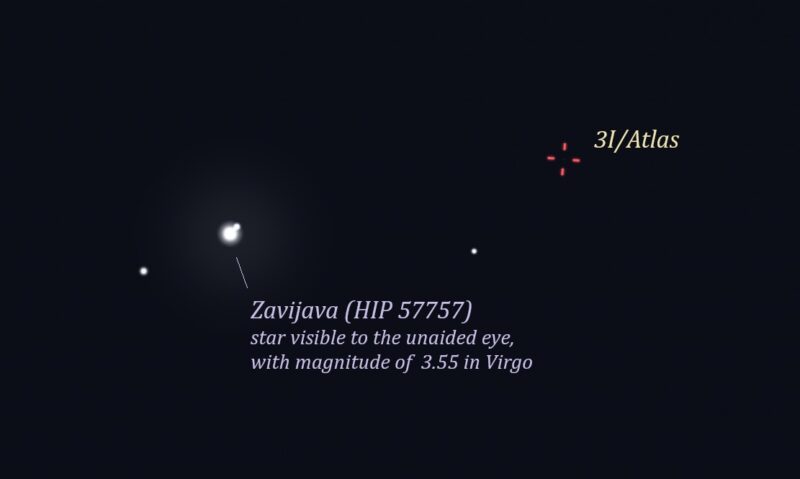
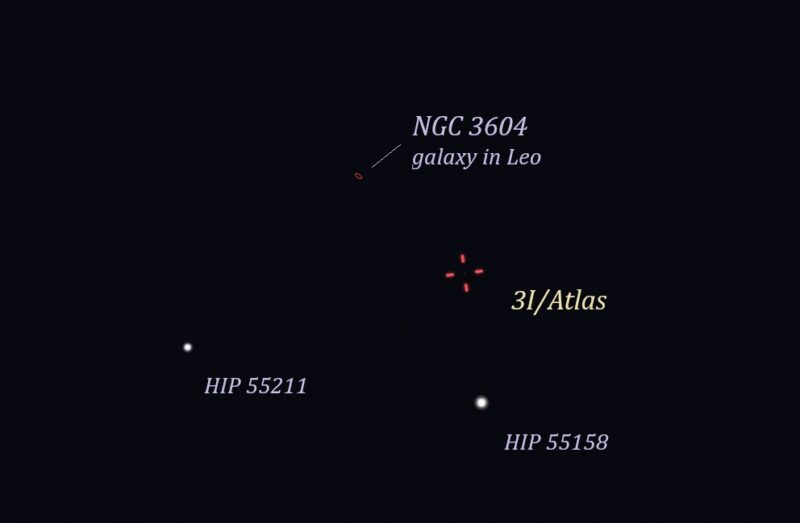
Bottom line: Interstellar object 3I/ATLAS just made its closest pass by the sun. It’s now headed out of our solar system. But there are still chances for you to see it! Read more here.
Via:
Read more: Comet Lemmon might be the best comet of 2025
Read more: New comet C/2025 R2 (SWAN) is becoming more visible
